This article relies largely or entirely on a single source .(September 2022) |
Differences between Shinjitai and Simplified characters in the Japanese and Chinese languages exist.
This article relies largely or entirely on a single source .(September 2022) |
Differences between Shinjitai and Simplified characters in the Japanese and Chinese languages exist.
The old and new forms of the Kyōiku Kanji and their Hànzì equivalents are listed below. [1]
In the following lists, the characters are sorted by the radicals of the Japanese kanji. The two Kokuji 働 and 畑 in the Kyōiku Kanji List, which have no Chinese equivalents, are not listed here; in Japanese, neither character was affected by the simplifications.
(The following characters were simplified neither in Japanese nor in Chinese.)
About 30% of the simplified Chinese characters match the Japanese shinjitai.
Some of the traditional Kanji are not included in the Japanese font of Windows XP/2000, and only rectangles are shown. Downloading the Meiryo font from the Microsoft website (VistaFont_JPN.EXE) and installing it will solve this problem.
Note that within the Jōyō Kanji there are 62 characters the old forms of which may cause problems displaying:
Kyōiku Kanji (26):
Secondary-School Kanji (36):
These characters are Unicode CJK Unified Ideographs for which the old form ( kyūjitai ) and the new form ( shinjitai ) have been unified under the Unicode standard. Although the old and new forms are distinguished under the JIS X 0213 standard, the old forms map to Unicode CJK Compatibility Ideographs which are considered by Unicode to be canonically equivalent to the new forms and may not be distinguished by user agents. Therefore, depending on the user environment, it may not be possible to see the distinction between old and new forms of the characters. In particular, all Unicode normalization methods merge the old characters with the new ones.
| Different stroke orders of the character 必, from black to red. | |||
 Traditional |  ROC, Hong Kong & Macau | 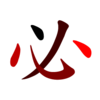 Japan | 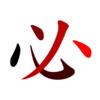 Mainland China |
Some characters, whether simplified or not, look the same in Chinese and Japanese, but have different stroke orders. For example, in Japan, 必 is written with the top dot first, while the Traditional stroke order writes the 丿 first. In the characters 王 and 玉, the vertical stroke is the third stroke in Chinese, but the second stroke in Japanese. Taiwan, Hong Kong and Macau use Traditional characters, though with an altered stroke order.
Han unification is an effort by the authors of Unicode and the Universal Character Set to map multiple character sets of the Han characters of the so-called CJK languages into a single set of unified characters. Han characters are a feature shared in common by written Chinese (hanzi), Japanese (kanji), Korean (hanja) and Vietnamese.
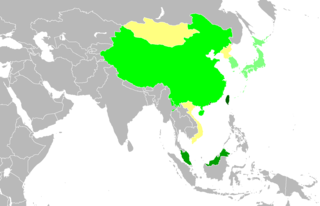
Traditional Chinese characters are a standard set of characters used to write Chinese languages. In Taiwan, the set of traditional characters is regulated by Taiwan's Ministry of Education, standardized in the Standard Form of National Characters. These forms were predominant in written Chinese until the middle of the 20th century, when various countries that use Chinese characters began standardizing simplified sets of characters, often with characters that existed before as well-known variants of the predominant forms.
Jinmeiyō kanji are a set of 863 Chinese characters known as "name kanji" in English. They are a supplementary list of characters that can legally be used in registered personal names in Japan, despite not being in the official list of "commonly used characters". "Jinmeiyō kanji" is sometimes used to refer to the characters in both the jinmeiyō and jōyō lists because some Japanese names do not require the specified Jinmeiyō kanji and are written entirely in Jōyō kanji. Hence Jōyō kanji can also be viewed as a subset of Jinmeiyō kanji.
Kyōiku kanji, also known as Gakunenbetsu kanji haitōhyō is a list of 1,026 kanji and associated readings developed and maintained by the Japanese Ministry of Education that prescribes which kanji, and which readings of kanji, Japanese students should learn from first grade to the sixth grade. Although the list is designed for Japanese students, it can also be used as a sequence of learning characters by non-native speakers as a means of focusing on the most commonly used kanji.

Biangbiang noodles, alternatively known as youpo chemian (油泼扯面) in Chinese, are a type of Chinese noodle originating from Shaanxi cuisine. The noodles, touted as one of the "eight curiosities" of Shaanxi (陕西八大怪), are described as being like a belt, owing to their thickness and length.
Shinjitai are the simplified forms of kanji used in Japan since the promulgation of the Tōyō Kanji List in 1946. Some of the new forms found in shinjitai are also found in Simplified Chinese characters, but shinjitai is generally not as extensive in the scope of its modification.

In Japanese language, Ryakuji are colloquial simplifications of kanji.
Asahi characters are forms of Kanji particular to the Asahi Shimbun newspaper. Unlike Simplified Chinese, where simplifications apply to all characters, the general custom in Japanese publications is to print Jōyō/Jinmeiyō Kanji in simplified Shinjitai forms, and to print Hyōgaiji using their original, unsimplified Kyūjitai forms. For example, the Jōyō Kanji 齊, 齋, 劑, 濟 are printed in their Shinjitai forms 斉, 斎, 剤, 済, but the Hyōgaiji 臍, 纃, 薺 remain unsimplified.
Kyūjitai are the traditional forms of kanji. Their simplified counterparts are shinjitai. Some of the simplified characters arose centuries ago and were in everyday use in both China and Japan, but they were considered inelegant, even uncouth. After World War II, simplified character forms were made official in both these countries.

Radical 213 meaning "turtle" is one of only two of the 214 Kangxi radicals that are composed of 16 strokes.
Extended shinjitai is the extension of the shinjitai. They are the simplified versions of some of the hyōgaiji. They are unofficial characters; the official forms of these hyōgaiji are still kyūjitai.

Radical 11 or radical enter (入部) meaning "enter", "come in (to)", "join" is one of 23 of the 214 Kangxi radicals that are composed of 2 strokes.

Radical 140 or radical grass (艸部) meaning "grass" is one of 29 of the 214 Kangxi radicals that are composed of 6 strokes. It transforms into 艹 when appearing at the top of a character or component. In the Kangxi Dictionary and in modern standard Traditional Chinese as used in Taiwan, Hong Kong and Macau, 艹 consists of four strokes, while in Simplified Chinese and modern Japanese, 艹 consists of three strokes.
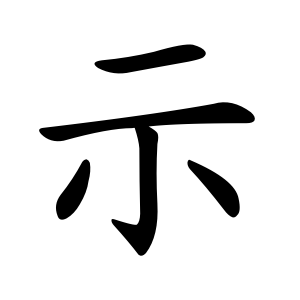
Radical 113 or radical spirit (示部) meaning ancestor or veneration is number 113 out of the 214 Kangxi radicals. It is one of the 23 radicals composed of 5 strokes. When appearing at the left side of a character, the radical transforms into 礻 in modern Chinese and Japanese jōyō kanji.

Radical 63 or radical door (戶部) meaning "door" is one of the 34 Kangxi radicals composed of 4 strokes.

Radical 64 or radical hand (手部) meaning "hand" is one of the 34 Kangxi radicals composed of 4 strokes.
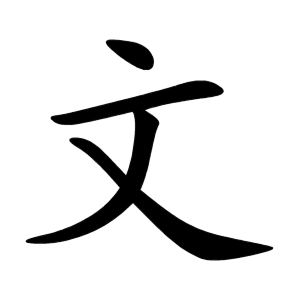
Radical 67 or radical script (文部) meaning "script" or "literature" is one of the 34 Kangxi radicals composed of 4 strokes.
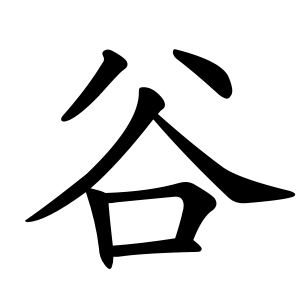
Radical 150 or radical valley (谷部) meaning "valley" is one of the 20 Kangxi radicals composed of 7 strokes.
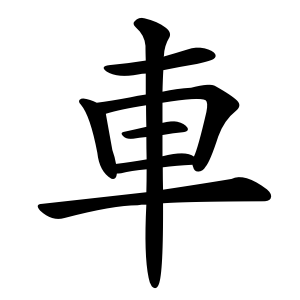
Radical 159 or radical cart (車部) meaning "cart" or "car" is one of the 20 Kangxi radicals composed of 7 strokes.